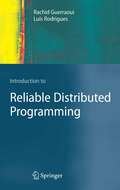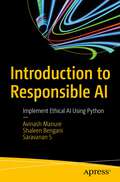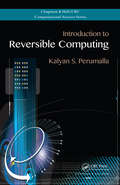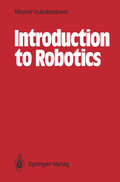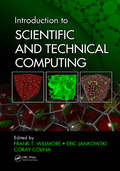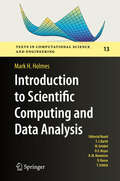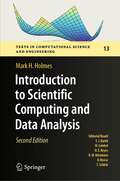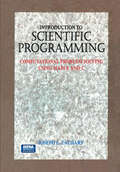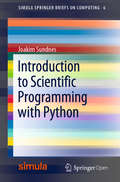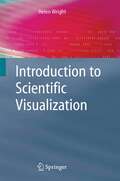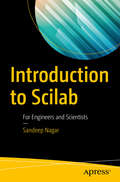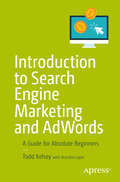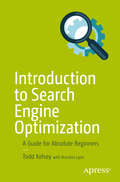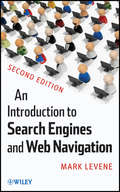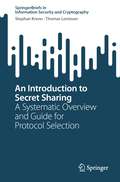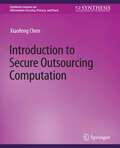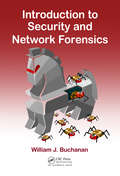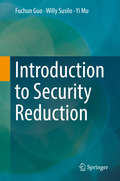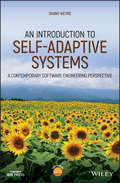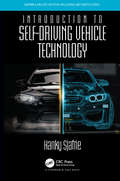- Table View
- List View
Introduction to Reliable Distributed Programming
by Rachid Guerraoui Luís RodriguesIn modern computing a program is usually distributed among several processes. The fundamental challenge when developing reliable distributed programs is to support the cooperation of processes required to execute a common task, even when some of these processes fail. Guerraoui and Rodrigues present an introductory description of fundamental reliable distributed programming abstractions as well as algorithms to implement these abstractions. The authors follow an incremental approach by first introducing basic abstractions in simple distributed environments, before moving to more sophisticated abstractions and more challenging environments. Each core chapter is devoted to one specific class of abstractions, covering reliable delivery, shared memory, consensus and various forms of agreement. This textbook comes with a companion set of running examples implemented in Java. These can be used by students to get a better understanding of how reliable distributed programming abstractions can be implemented and used in practice. Combined, the chapters deliver a full course on reliable distributed programming. The book can also be used as a complete reference on the basic elements required to build reliable distributed applications.
Introduction to Responsible AI: Implement Ethical AI Using Python
by Avinash Manure Shaleen Bengani Saravanan SLearn and implement responsible AI models using Python. This book will teach you how to balance ethical challenges with opportunities in artificial intelligence. The book starts with an introduction to the fundamentals of AI, with special emphasis given to the key principles of responsible AI. The authors then walk you through the critical issues of detecting and mitigating bias, making AI decisions understandable, preserving privacy, ensuring security, and designing robust models. Along the way, you’ll gain an overview of tools, techniques, and code examples to implement the key principles you learn in real-world scenarios. The book concludes with a chapter devoted to fostering a deeper understanding of responsible AI’s profound implications for the future. Each chapter offers a hands-on approach, enriched with practical insights and code snippets, enabling you to translate ethical considerations into actionable solutions. What You Will Learn Understand the principles of responsible AI and their importance in today's digital worldMaster techniques to detect and mitigate bias in AIExplore methods and tools for achieving transparency and explainabilityDiscover best practices for privacy preservation and security in AIGain insights into designing robust and reliable AI models Who This Book Is For AI practitioners, data scientists, machine learning engineers, researchers, policymakers, and students interested in the ethical aspects of AI
Introduction to Reversible Computing: Introduction To Reversible Computing
by Kalyan S. PerumallaFew books comprehensively cover the software and programming aspects of reversible computing. Filling this gap, Introduction to Reversible Computing offers an expanded view of the field that includes the traditional energy-motivated hardware viewpoint as well as the emerging application-motivated software approach. Collecting scattered knowledge in
Introduction to Scientific and Technical Computing
by FRANK T. WILLMORE, ERIC JANKOWSKI AND CORAY COLINACreated to help scientists and engineers write computer code, this practical book addresses the important tools and techniques that are necessary for scientific computing, but which are not yet commonplace in science and engineering curricula. This book contains chapters summarizing the most important topics that computational researchers need to know about. It leverages the viewpoints of passionate experts involved with scientific computing courses around the globe and aims to be a starting point for new computational scientists and a reference for the experienced. Each contributed chapter focuses on a specific tool or skill, providing the content needed to provide a working knowledge of the topic in about one day. While many individual books on specific computing topics exist, none is explicitly focused on getting technical professionals and students up and running immediately across a variety of computational areas.
Introduction to Scientific and Technical Computing
by Frank T. Willmore Eric Jankowski Coray ColinaCreated to help scientists and engineers write computer code, this practical book addresses the important tools and techniques that are necessary for scientific computing, but which are not yet commonplace in science and engineering curricula. This book contains chapters summarizing the most important topics that computational researchers need to know about. It leverages the viewpoints of passionate experts involved with scientific computing courses around the globe and aims to be a starting point for new computational scientists and a reference for the experienced. Each contributed chapter focuses on a specific tool or skill, providing the content needed to provide a working knowledge of the topic in about one day. While many individual books on specific computing topics exist, none is explicitly focused on getting technical professionals and students up and running immediately across a variety of computational areas.
Introduction to Scientific Computing and Data Analysis (Texts in Computational Science and Engineering #13)
by Mark H. HolmesThis textbook provides and introduction to numerical computing and its applications in science and engineering. The topics covered include those usually found in an introductory course, as well as those that arise in data analysis. This includes optimization and regression based methods using a singular value decomposition. The emphasis is on problem solving, and there are numerous exercises throughout the text concerning applications in engineering and science. The essential role of the mathematical theory underlying the methods is also considered, both for understanding how the method works, as well as how the error in the computation depends on the method being used. The MATLAB codes used to produce most of the figures and data tables in the text are available on the author’s website and SpringerLink.
Introduction to Scientific Computing and Data Analysis (Texts in Computational Science and Engineering #13)
by Mark H. HolmesThis textbook provides an introduction to numerical computing and its applications in science and engineering. The topics covered include those usually found in an introductory course, as well as those that arise in data analysis. This includes optimization and regression-based methods using a singular value decomposition. The emphasis is on problem solving, and there are numerous exercises throughout the text concerning applications in engineering and science. The essential role of the mathematical theory underlying the methods is also considered, both for understanding how the method works, as well as how the error in the computation depends on the method being used. The codes used for most of the computational examples in the text are available on GitHub. This new edition includes material necessary for an upper division course in computational linear algebra.
Introduction to Scientific Programming: Computational Problem Solving Using Maple and C
by Joseph L. Zachary"Introduction to Computational Science" was developed over a period of two years at the University of Utah Department of Computer Science in conjunction with the U.S. Department of Energy-funded Undergraduate Computation in Engineering Science (UCES) program. Each chapter begins by introducing a problem and then guiding the student through its solution. The computational techniques needed to solve the problem are developed as necassary, making the motivation for learning the computing alwasy apparent. Each chapter will introduce a single problem that will be used to motivate a single computing concept. The notes currently consist of 15 chapters. The first seven chapters deal with Maple and the last eight with C. The textbook will contain 20 to 30 chapters covering a similar mix of concepts at a finer level of detail.
Introduction to Scientific Programming with Python (Simula SpringerBriefs on Computing #6)
by Joakim SundnesThis open access book offers an initial introduction to programming for scientific and computational applications using the Python programming language. The presentation style is compact and example-based, making it suitable for students and researchers with little or no prior experience in programming. The book uses relevant examples from mathematics and the natural sciences to present programming as a practical toolbox that can quickly enable readers to write their own programs for data processing and mathematical modeling. These tools include file reading, plotting, simple text analysis, and using NumPy for numerical computations, which are fundamental building blocks of all programs in data science and computational science. At the same time, readers are introduced to the fundamental concepts of programming, including variables, functions, loops, classes, and object-oriented programming. Accordingly, the book provides a sound basis for further computer science and programming studies.
Introduction to Scientific Visualization
by Helen WrightThis is a ‘how to’ book for scientific visualization. The book does not treat the subject as a subset of information visualisation, but rather as a subject in its own right. An introduction on the philosophy of the subject sets the scene and the theory of colour perception is introduced. Next, using Brodlie’s taxonomy to underpin its core chapters, it is shown how to classify data. Worked examples are given throughout the text and there are practical ‘sidebars’ for readers with access to the IRIS Explorer software who can try out the demonstrations on an accompanying website. The book concludes with a ‘taster’ of ongoing research.
Introduction to Scilab: For Engineers and Scientists
by Sandeep NagarFamiliarize yourself with Scilab using this concise, practical tutorial that is focused on writing code to learn concepts. Starting from the basics, this book covers array-based computing, plotting, and working with files in Scilab. Introduction to Scilab is useful for industry engineers, researchers, and students who are looking for open-source solutions for numerical computation.In this book you will learn by doing, avoiding technical jargon, which makes the concepts easy to learn. First you’ll see how to run basic calculations, absorbing technical complexities incrementally as you progress toward advanced topics. Throughout, the language is kept simple to ensure that readers at all levels can grasp the concepts. After reading this book, you will come away with sample code that can be re-purposed and applied to your own projects using Scilab.What You'll LearnApply sample code to your engineering or science problemsWork with Scilab arrays, functions, and loops Use Scilab’s plotting functions for data visualizationSolve numerical computing and computational engineering problems with ScilabWho This Book Is ForEngineers, scientists, researchers, and students who are new to Scilab. Some prior programming experience would be helpful but not required.
Introduction to Search Engine Marketing and AdWords: A Guide for Absolute Beginners
by Todd KelseyUse Google's AdWords to create your ads. Each chapter goes beyond the tool itself, discussing helpful resources and important issues to keep in mind. If you are completely new to search engine marketing and AdWords and you want to learn the basics, this guide will introduce you to the content quickly.Introduction to Search Engine Marketing and AdWords is not in-depth, comprehensive, or trying to cover every tool or platform—an impossible task! But it is an easy-to-understand introduction to the most important tools and skills in search engine marketing. What You’ll Learn Take a behind-the-scenes tour of AdWords, including how to create an accountCreate and launch a campaign as well as ads, including keyword toolsMonitor a campaign, including time frame, clicks and CTR, and reportingImplement various campaign strategies, including support email and dealing with errorsUse Ad extensions as well as site links Who This Book Is For Those who need to get up to speed on search engine marketing tools and techniques for business or personal use. This book is also suitable as a student reference.
Introduction to Search Engine Optimization: A Guide for Absolute Beginners
by Todd KelseyDon't be intimidated by all the search engine optimization (SEO) tools out there. You will start out learning about keywords and the importance of quality content and then walk through incremental steps as you try out the tools and master the tips and strategies. If you are completely new to search engine optimization and you want to learn the basics, this guide will introduce you to the content quickly.Introduction to Search Engine Optimization is a detailed guide to the most important tools and skills needed to accurately and effectively utilize search engine optimization. This book covers SEO basics, keyword research, SEO ranking and analytics, Google Analytics, and more. It also includes an overview of how to pursue SEO-related certifications. What You’ll LearnCreate a content platform, including blogs and YouTube channelsUse keywords to maximize findability and increase search volumeCheck your SEO rank and other analyticsHunt for duplicate contentSet up Google Analytics, including BloggerUtilize Indexing and Webmaster tools/search console Who This Book Is ForThose who need to get up to speed on search engine optimization tools and techniques for business or personal use. This book is also suitable as a student reference.
An Introduction to Search Engines and Web Navigation
by Mark LeveneThis book is a second edition, updated and expanded to explain the technologies that help us find information on the web. Search engines and web navigation tools have become ubiquitous in our day to day use of the web as an information source, a tool for commercial transactions and a social computing tool. Moreover, through the mobile web we have access to the web's services when we are on the move. This book demystifies the tools that we use when interacting with the web, and gives the reader a detailed overview of where we are and where we are going in terms of search engine and web navigation technologies.
An Introduction to Search Engines and Web Navigation
by Mark LeveneThis book is a second edition, updated and expanded to explain the technologies that help us find information on the web. Search engines and web navigation tools have become ubiquitous in our day to day use of the web as an information source, a tool for commercial transactions and a social computing tool. Moreover, through the mobile web we have access to the web's services when we are on the move. This book demystifies the tools that we use when interacting with the web, and gives the reader a detailed overview of where we are and where we are going in terms of search engine and web navigation technologies.
An Introduction to Secret Sharing: A Systematic Overview and Guide for Protocol Selection (SpringerBriefs in Information Security and Cryptography)
by Stephan Krenn Thomas LorünserThis book provides an introduction to secret sharing, a key technology for practical applications and higher-level cryptographic protocols. This survey analyzes existing work, and systematically presents secret sharing protocols for various adversary models. It provides intuitive as well as formal descriptions of the different types of adversaries, including their computational powers and capabilities. In addition, it then offers guidance and support in selecting the appropriate type of protocol for a given application domain, present representative protocols, and provide useful references for further reading and research. This book aims to support software developers and engineers in realizing highly secure cloud-based applications, and also provides an introduction to the field including some relevant technical background for interested students and computer scientists.
Introduction to Secure Outsourcing Computation (Synthesis Lectures on Information Security, Privacy, and Trust)
by Xiaofeng ChenWith the rapid development of cloud computing, the enterprises and individuals can outsource their sensitive data into the cloud server where they can enjoy high quality data storage and computing services in a ubiquitous manner. This is known as the outsourcing computation paradigm. Recently, the problem for securely outsourcing various expensive computations or storage has attracted considerable attention in the academic community. In this book, we focus on the latest technologies and applications of secure outsourcing computations. Specially, we introduce the state-of-the-art research for secure outsourcing some specific functions such as scientific computations, cryptographic basic operations, and verifiable large database with update. The constructions for specific functions use various design tricks and thus result in very efficient protocols for real-world applications. The topic of outsourcing computation is a hot research issue nowadays. Thus, this book will be beneficial to academic researchers in the field of cloud computing and big data security.
Introduction to Security
by Robert Fischer Edward HalibozekIntroduction to Security has been the leading introduction to private security for over 30 years, celebrated for its balanced and professional approach to this increasingly important area. Now the 8th edition expands the key topics and adds material important in the 21st century environment. The author team brings together top-level professional experience in industry with years of teaching experience. As a recommended title for security certifications, it is a crucial resource for the 30,000+ ASIS International members, and is also used as a core security textbook in universities throughout the country. This is Butterworth-Heinemann's best-selling security text of all time, an essential reference for all security professionals.Significantly expanded chapters on computer issues, cargo, homeland security and terrorismNew chapter on Internal Issues and Controls covering crucial information on internal theft, personnel policies, and drugs and violence in the workplaceMore illustrations and photos to make learning easier
Introduction to Security and Network Forensics
by William J. BuchananKeeping up with the latest developments in cyber security requires ongoing commitment, but without a firm foundation in the principles of computer security and digital forensics, those tasked with safeguarding private information can get lost in a turbulent and shifting sea. Providing such a foundation, Introduction to Security and N
Introduction to Security Reduction
by Fuchun Guo Willy Susilo Yi MuThis monograph illustrates important notions in security reductions and essential techniques in security reductions for group-based cryptosystems. Using digital signatures and encryption as examples, the authors explain how to program correct security reductions for those cryptographic primitives. Various schemes are selected and re-proven in this book to demonstrate and exemplify correct security reductions. This book is suitable for researchers and graduate students engaged with public-key cryptography.
An Introduction to Self-adaptive Systems: A Contemporary Software Engineering Perspective (Wiley - IEEE)
by Danny WeynsA concise and practical introduction to the foundations and engineering principles of self-adaptation Though it has recently gained significant momentum, the topic of self-adaptation remains largely under-addressed in academic and technical literature. This book changes that. Using a systematic and holistic approach, An Introduction to Self-adaptive Systems: A Contemporary Software Engineering Perspective provides readers with an accessible set of basic principles, engineering foundations, and applications of self-adaptation in software-intensive systems. It places self-adaptation in the context of techniques like uncertainty management, feedback control, online reasoning, and machine learning while acknowledging the growing consensus in the software engineering community that self-adaptation will be a crucial enabling feature in tackling the challenges of new, emerging, and future systems. The author combines cutting-edge technical research with basic principles and real-world insights to create a practical and strategically effective guide to self-adaptation. He includes features such as: An analysis of the foundational engineering principles and applications of self-adaptation in different domains, including the Internet-of-Things, cloud computing, and cyber-physical systems End-of-chapter exercises at four different levels of complexity and difficulty An accompanying author-hosted website with slides, selected exercises and solutions, models, and code Perfect for researchers, students, teachers, industry leaders, and practitioners in fields that directly or peripherally involve software engineering, as well as those in academia involved in a class on self-adaptivity, this book belongs on the shelves of anyone with an interest in the future of software and its engineering.
An Introduction to Self-adaptive Systems: A Contemporary Software Engineering Perspective (Wiley - IEEE)
by Danny WeynsA concise and practical introduction to the foundations and engineering principles of self-adaptation Though it has recently gained significant momentum, the topic of self-adaptation remains largely under-addressed in academic and technical literature. This book changes that. Using a systematic and holistic approach, An Introduction to Self-adaptive Systems: A Contemporary Software Engineering Perspective provides readers with an accessible set of basic principles, engineering foundations, and applications of self-adaptation in software-intensive systems. It places self-adaptation in the context of techniques like uncertainty management, feedback control, online reasoning, and machine learning while acknowledging the growing consensus in the software engineering community that self-adaptation will be a crucial enabling feature in tackling the challenges of new, emerging, and future systems. The author combines cutting-edge technical research with basic principles and real-world insights to create a practical and strategically effective guide to self-adaptation. He includes features such as: An analysis of the foundational engineering principles and applications of self-adaptation in different domains, including the Internet-of-Things, cloud computing, and cyber-physical systems End-of-chapter exercises at four different levels of complexity and difficulty An accompanying author-hosted website with slides, selected exercises and solutions, models, and code Perfect for researchers, students, teachers, industry leaders, and practitioners in fields that directly or peripherally involve software engineering, as well as those in academia involved in a class on self-adaptivity, this book belongs on the shelves of anyone with an interest in the future of software and its engineering.
Introduction to Self-Driving Vehicle Technology (Chapman & Hall/CRC Artificial Intelligence and Robotics Series)
by Hanky SjafrieThis book aims to teach the core concepts that make Self-driving vehicles (SDVs) possible. It is aimed at people who want to get their teeth into self-driving vehicle technology, by providing genuine technical insights where other books just skim the surface. The book tackles everything from sensors and perception to functional safety and cybersecurity. It also passes on some practical know-how and discusses concrete SDV applications, along with a discussion of where this technology is heading. It will serve as a good starting point for software developers or professional engineers who are eager to pursue a career in this exciting field and want to learn more about the basics of SDV algorithms. Likewise, academic researchers, technology enthusiasts, and journalists will also find the book useful. Key Features: Offers a comprehensive technological walk-through of what really matters in SDV development: from hardware, software, to functional safety and cybersecurity Written by an active practitioner with extensive experience in series development and research in the fields of Advanced Driver Assistance Systems (ADAS) and Autonomous Driving Covers theoretical fundamentals of state-of-the-art SLAM, multi-sensor data fusion, and other SDV algorithms. Includes practical information and hands-on material with Robot Operating System (ROS) and Open Source Car Control (OSCC). Provides an overview of the strategies, trends, and applications which companies are pursuing in this field at present as well as other technical insights from the industry.
Introduction to Self-Driving Vehicle Technology (Chapman & Hall/CRC Artificial Intelligence and Robotics Series)
by Hanky SjafrieThis book aims to teach the core concepts that make Self-driving vehicles (SDVs) possible. It is aimed at people who want to get their teeth into self-driving vehicle technology, by providing genuine technical insights where other books just skim the surface. The book tackles everything from sensors and perception to functional safety and cybersecurity. It also passes on some practical know-how and discusses concrete SDV applications, along with a discussion of where this technology is heading. It will serve as a good starting point for software developers or professional engineers who are eager to pursue a career in this exciting field and want to learn more about the basics of SDV algorithms. Likewise, academic researchers, technology enthusiasts, and journalists will also find the book useful. Key Features: Offers a comprehensive technological walk-through of what really matters in SDV development: from hardware, software, to functional safety and cybersecurity Written by an active practitioner with extensive experience in series development and research in the fields of Advanced Driver Assistance Systems (ADAS) and Autonomous Driving Covers theoretical fundamentals of state-of-the-art SLAM, multi-sensor data fusion, and other SDV algorithms. Includes practical information and hands-on material with Robot Operating System (ROS) and Open Source Car Control (OSCC). Provides an overview of the strategies, trends, and applications which companies are pursuing in this field at present as well as other technical insights from the industry.
